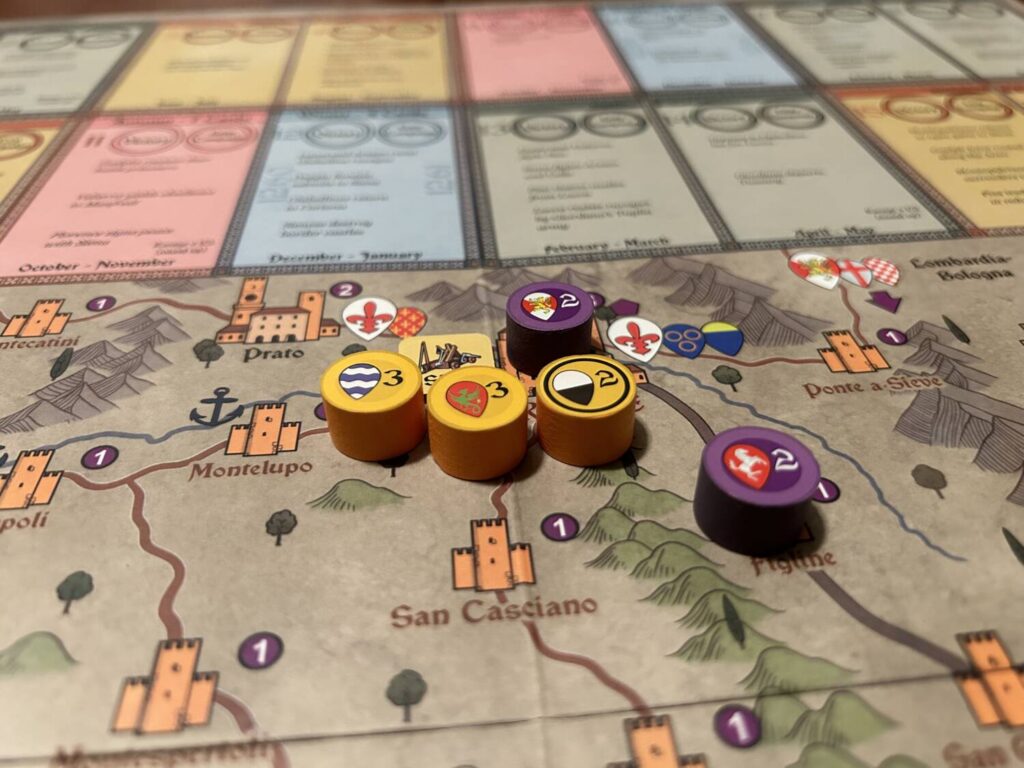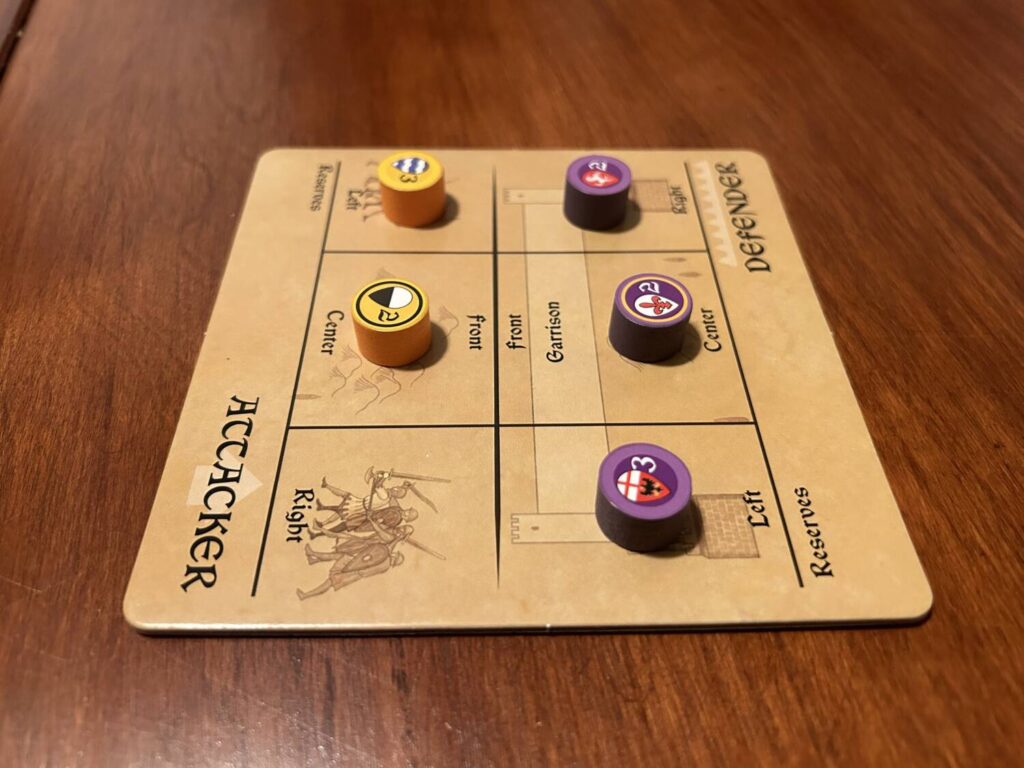Disclosure: Meeple Mountain received a free copy of this product in exchange for an honest, unbiased review. This review is not intended to be an endorsement.
Inferno: Guelphs and Ghibellines Vie for Tuscany, 1259–1261 is a staggering design. Let’s get that out of the way now. GMT’s Levy & Campaign series has developed a sterling reputation in only three titles for good reason. Each presents two players with a medieval military campaign, waged over a prolonged period of time. What separates the series from a number of its kin? Levy & Campaign keeps an eye keenly focused on the bookkeeping of war, on the costs in money and resources.
While the first volume, Nevsky, took place in Scandinavia, and Almoravid—which, for whatever it’s worth, has probably my favorite GMT cover—covers Muslim-Christian conflict in Spain, Inferno takes place in Tuscany, where Firenze and Siena duke it out for control of the Italian countryside.

Rules
I won’t be going into much detail here. With a game like Inferno, the rules aren’t likely to make or break your interest. If you’re reading this review, you’re probably already interested in the game, and just want to know that your interest isn’t misplaced. It isn’t. If this isn’t your first war game rodeo, you’ll be in good shape. If it is, know that the rules are simultaneously a lot and, frankly, not as bad as they first seem. More on that in the next section.
Like many macro scale war games, Inferno has you wage war across a large map, littered with cities and routes. You siege locations, engage in direct combat, and enlist the services of your vassals. What makes Inferno special boils down to a few key features:
- The production. GMT as a publisher has pushed itself beyond anything we’ve seen from them before. The box is gorgeous. The board is gorgeous. The wooden components are gorgeous. There has been a noticeable uptick in production quality at GMT over the last couple of years, and Inferno is reaping all the benefits.
- The flexibility in campaign length is enormous. The shortest Inferno campaign can be played in under an hour, provided both players know what they’re doing. The longest campaign can last the better part of a day, a wondrous bath of an experience.
- As I mentioned above, resource management is important in all of the Levy & Campaign games. Keeping bands of troops active on the board costs you money and resources. At the end of each season, you have to pay your vassals for their service, or they’ll pack up and head home. The long game of Inferno has a unique texture as a result. Your troops are not always yours.
- The command system is fantastic. At the beginning of each season, both players choose and order a predetermined number of their command cards, which are linked to specific units on the board. Players alternate revealing one card at a time, performing an action or passing as they see fit. This is the game’s primary source of dramatic tension. Where will your opponent focus their efforts first? Can you match them? Can you take advantage of a near-certain push in one region to exploit weaknesses in another? Will your opponent make the move you expect when you expect it? Inferno raises the same questions as many other large-scale campaign games, but it goes about the whole thing with an immediacy and a flair for the dramatic that sets it apart.

Rulebook
With my effusive praise out of the way, let’s talk about the rulebook. GMT makes a terrible rulebook. They are known for it. I touched on the issue in my review of The Barracks Emperors, but whereas that (magnificent) game was merely inconvenienced by its manual, this (magnificent) game is hobbled by it. It took me months to get Inferno to the table, entirely because of the manual.
As is chronically the case with GMT games, this is not an instruction manual designed to teach a new player. It is a reference document, intended to effectively answer questions that occur during play. In that role, it is superb! Reference is not the sole purpose of a manual, though, and I firmly believe that certain GMT games, ones with the potential to be more popular, don’t take off because they deny players a smooth runway.
Root, directly inspired by Ruhnke and GMT’s series of COIN games, does this right. Root includes The Law of Root, a reference manual meant for niggling questions and edge cases, along with a How to Play quick start manual, which leads players through enough of a game to cover all of the core concepts. Is Root easier to learn with an experienced player at the table? Of course. Is it also published with an eye towards making it as approachable as possible? Yes.
My first GMT game was Commanchería, the manual for which includes a protracted play through, which is cross-indexed with the reference manual. It encourages you to take a moment to read the rules for each new aspect of gameplay as it comes up. It took a bit to grow comfortable with that (magnificent) game, but I felt at ease the whole time, and I was more than ready to continue on my own when the manual left me to my own devices. Inferno comes with a painfully brief play through, which is better than many GMT games, but it isn’t enough.
This is a manual in which information isn’t arranged in the order you need to onboard it. Concepts that haven’t been clarified are mentioned casually. Nothing is presented in a way that encourages the information you’re reading now to build upon the information you’ve already read. Inferno is a complex game, there’s no questioning that, but it isn’t as complex as its manual makes it out to be. Inferno is so good, so beautifully published, and such a rich experience, it would be an incredible ambassador for this niche within a niche. To some extent, with manuals like this, GMT is shooting their corner of the hobby in the foot.
Separate from the issue of the manual, Inferno is about as good as a game can be. If you think you’d like it, you will. It’s masterful. Designers Enrico Acerbi and Volko Ruhnke have created an out-and-out masterpiece. It is full of rich decisions, satisfying conflict, fun reversals of fortune, and an intriguing series of mechanics centered around the cards. This is a game you can play again and again and again, never having the same experience twice. I can’t say enough good things about it.
Shame about that manual.













Add Comment